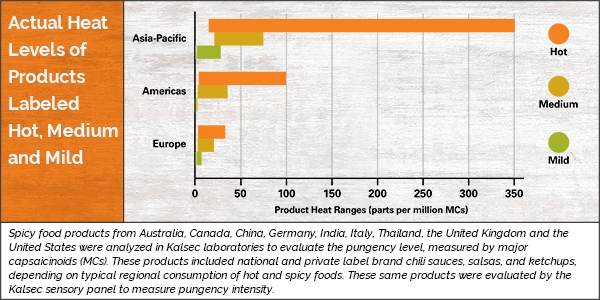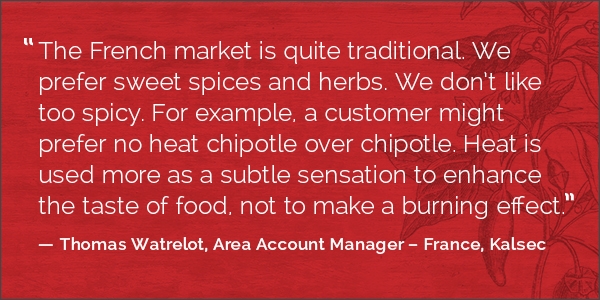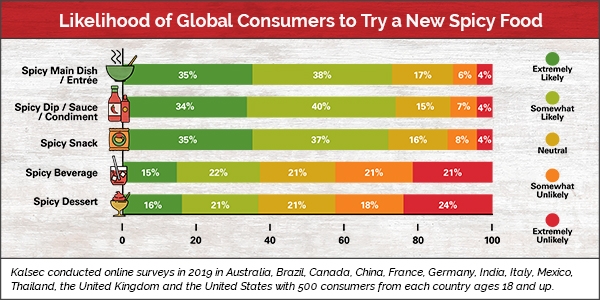Promotional Features
Why the Hot & Spicy Food Trend is an Exciting Opportunity
Chili peppers play an important role in the food industry today. They enhance the flavor—heat, pungency, warmth and bite—as well as the color of prepared foods. For food manufacturers, these ingredients often come in the form of an extract. As regional cuisines have become more globalized, consumer preference for foods that incorporate heat has increased significantly.
In a 2019 survey conducted by Kalsec®, a leading global producer of innovative spice and herb flavor extracts, more than half of consumers said that they choose spicy options for their meals. This number has doubled compared to data from 2017, underscoring the opportunity presented by hot and spicy foods.
This survey is part of Kalsec’s new research on hot and spicy food trends and applications, which can help food processors, manufacturers, quick service restaurants and consumer packaged goods companies create innovative product offerings. The research is vital if you want to capitalize on one of the hottest trends in the food industry today. It details regional preferences and application opportunities to inform your product development strategy and help you get ahead.
Here are some of the insights and opportunities uncovered by Kalsec’s research.
Interest in and consumption of spicy foods has grown significantly this year.
Consumers are eating more hot and spicy foods in general, and they are looking for these kinds of products everywhere they go.
Consumers around the globe were surveyed in 2019, and more than 50 percent indicated that they choose spicy options when dining out and when making meals at home––a significant increase compared to 2017 data.
This presents an exciting opportunity for manufacturers to incorporate hot and spicy flavors and pungency levels into all kinds of savory applications, in addition to creating entirely new combinations.
Strategies for creating hot and spicy foods need to consider regional preferences, because perception of pungency varies across the globe.
Labeling products as ‘mild,’ ‘medium’ or ‘hot’ is a longstanding convention in the food industry, but these levels are loosely defined and vary greatly around the world.
To determine the heat levels in products from different regions, Kalsec scientists measured the concentration of major capsaicinoids (MCs) in dozens of samples.
The results showed that pungency levels vary widely, especially in products that are labeled ‘hot.’ You can also see how much pungency levels differ from region to region. Of the products tested, the ‘hottest’ products from Europe have the same MC concentration as the upper-end ‘mild’ products from the Asia-Pacific region. This means that European consumers might not enjoy the level of spiciness in products that Asia-Pacific consumers consider ‘mild.’
In addition to having different perceptions of heat, consumers have preferences for other aspects of hot and spicy foods that can vary by country within each region.
French consumers prefer subtle heat flavors that are not overtly spicy. And Mexican consumers prefer a high level of heat in their food––the only regional group to report this preference.
It is important for manufacturers to know their end customers in order to align their products with expected levels of spiciness, and to meet flavor and delivery system preferences. Doing so will help build demand for your products among your target audience.
When choosing applications, consider those that are familiar to your customer. They are most comfortable trying new spicy flavors in familiar savory foods.
Consumers surveyed are more likely to try spicy variations of savory foods where hot and spicy options are common. These application types include main dishes and entrées; dips, sauces and condiments; and snacks. Spicy desserts and beverages tend to appeal to a much smaller portion of consumers. However, these unique applications could become more popular as the hot and spicy food segment continues to grow.
Additionally, 62 percent of consumers agree that most savory foods taste better with some level of spiciness.
These insights mean that manufacturers do not need to create entirely new products in order to capitalize on hot and spicy food trends. Adding a spicy twist to savory applications that consumers know and love is a good place to start, and doing so can help you stand out from the competition.
Consumers demand specificity and transparency.
There continues to be high demand for transparency in the food industry, and hot and spicy products are not exempt.
Consumers want to know the specific pepper varietals, ingredients and flavor profiles that are found in your products. This demand is particularly pronounced in India, where three out of four people surveyed agree that ingredients contributing to heat should be from a specific source.
Labels and promotions need to be detailed, and this goes beyond manufacturers and processors. Restaurant operators will also benefit from listing specific ingredients on their menus.
Not only does this information help consumers make educated decisions, it is also an opportunity to highlight points of differentiation for each of your products. Being transparent about the heat ingredients you are using will help you engage consumers and build trust with them for years to come.
Manufacturers can take inspiration from the cuisines that consumers enjoy the most.
Some cuisines are popular around the world. Global research shows that, when asked about regional cuisines, consumers enjoy Mexican food the most, followed by Chinese, Indian and Thai food.
Getting inspiration from these cuisines can help you create products that are right on trend.
Read the complete research report.
The key findings outlined in this article underscore the opportunities to incorporate more hot and spicy flavors in your applications. But what you have read is just the start.
You can read Kalsec’s complete hot and spicy foods eBook, which includes consumer trend research and market analysis, at https://info.kalsec.com/download-spicy-food-trends.
Take action now to stay on the leading edge of the fast-moving, ever-evolving food industry.






